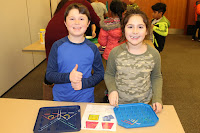STEAM
Art Science
Ever see art and think, "What in the world is that?"
Edvard Munch (Expressionism)
 |
| Pablo Picasso (Cubism) |
And then there is the Pop Art and Logos we have come to know and recognize instantly-
This month in STEAM we learned about lots a different artists and their styles and then we got to try out our own ideas
Mosaic Puzzle Art:
Rubber Bands Tangrams Art
Balance Bots
Sometimes you just need a buddy to keep your whole life in balance, and this one's a quickie!
And for the aspiring tight-rope walker, this bot is your new role model. Balancing on fingers, noses, or ledges, this bot knows no balancing bounds.
Materials:
2 wood skewers
1 toothpick
2 balls of plasticine (any clay will do)
2 google eyes and glue
This is a wonderful balance toy to
make, and then change around, iterate, and learn from!
Step
1: Insert Sticks and Add Clay!
First, insert the two wood skewers
so that they are angled down.
(You can play around with the position later to get all sorts of different balancing angles.)
Next, insert the toothpick on the
bottom of the cork facing down. Then add balls of clay to either
side. For the most part, balls about half the volume of a ping-pong ball work
great! Experiment to find the best for you.
We need Balance Bot's center of mass (clay masses) to be below the tip end of the toothpick by at least an inch or two.
Step
2: Add a Face and Let It Rip!
Every
bot can use a little personality. Googly eyes can make it come to life, and a
mouth isn't bad either. It can lay flat on the table, but
this bot is made to spin upright. Let it rip!
Great things to
change to get different results include:
- The length of the toothpick (cut it)
- The angle and length of the skewers (cut them), and re-poke them
- The size of the clay balls
*I used beads and clay for the
weights. The kids loved seeing how many ways they could balance the bot: on the
eraser of a pencil, on their ear or nose, on the end of a skewer, on the edge
of a sheet of paper.
Science:
All objects behave as though their mass (the
matter from which they are made) is concentrated at a point called
their center of gravity. A simple
spherical object, like a ball, has its center of gravity located at its center.
In a more complex object can be located somewhere else.
In your body, the center of gravity is typically slightly higher
than your waist, because more weight is in the top half of your body than in
the bottom half.
To create this toy that plays with gravity and equilibrium,
we will move a cork’s center of gravity away from its center, causing our
“Balancing Buddy” to rock and sway, but remain standing upright.
Here are some other experiments to try also:
First person to call me after viewing this blog, wins a prize. Kim Anderson (847) 289-5813










No comments:
Post a Comment